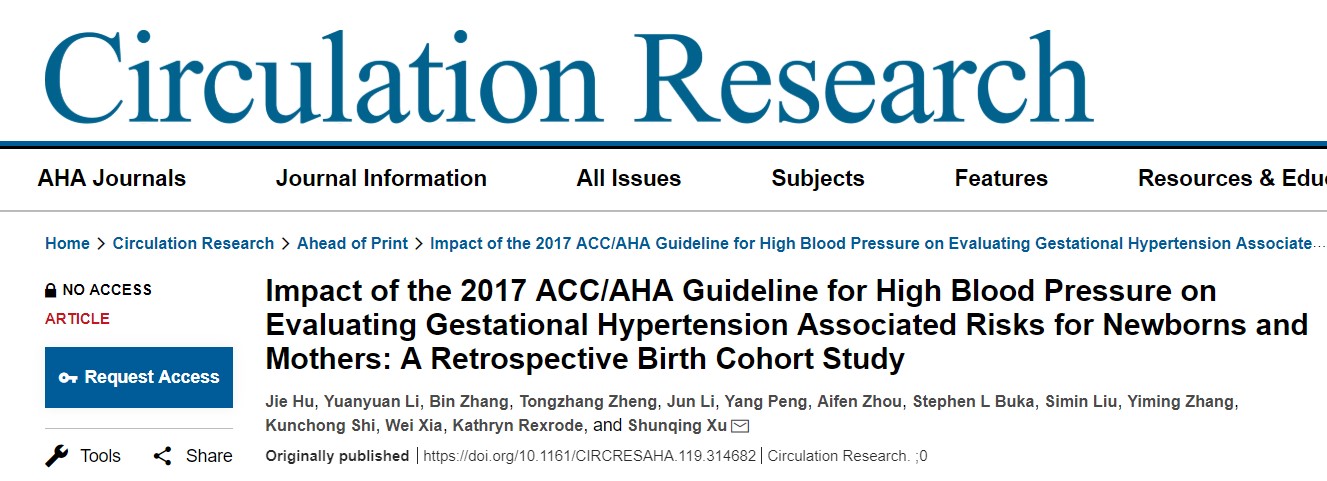Circulation Research published a study from Professor Shunqing Xu’s group of the school of public health, estimating the impact of adopting the 2017 ACC/AHA guideline for high blood pressure on gestational hypertension and associated adverse pregnancy outcomes for mothers and newborns
In May 21 2019, Circulation Research (IF=15.211) published an article entitled with “Impact of the 2017 ACC/AHA Guideline for High Blood Pressure on Evaluating Gestational Hypertension Associated Risks for Newborns and Mothers: A Retrospective Birth Cohort Study (Circulation Research, 2019 May 21, DOI: 10.1161/circresaha.119.314682).” This study provides evidence on the potential impact of the 2017 American College of Cardiology/American Heart Association (ACC/AHA) guideline on the detection, management, and prevention of high blood pressures during pregnancy. Findings of this study suggest that adopting the 2017 ACC/AHA guideline for high blood pressure in prenatal care would result in a large number of pregnant women labeled as having gestational hypertension, but could more accurately classify women and newborns at risk for adverse pregnancy outcomes. Professor Xu Shunqing is the corresponding author, and Drs. Hu Jie, Li Yuanyuan, and Zhang Bin are the co-first authors.
Hypertensive disorders in pregnancy are responsible for approximately 14% of maternal deaths worldwide. Infants of women with gestational hypertension have increased risk of adverse birth outcomes. The America College of Obstetricians and Gynecologists (ACOG) statement in 2013 defines gestational hypertension as the new-onset of hypertension (systolic blood pressure [SBP] ≥ 140 mmHg or diastolic blood pressure [DBP] ≥90 mmHg) after 20 weeks of gestation, usually near term, in the absence of accompanying proteinuria. In 2017, lower blood pressure values (SBP ≥ 130 mmHg or DBP≥ 80 mmHg) are recommended to identify hypertension according to the ACC/AHA Guideline for the Prevention, Detection, Evaluation and Management of High Blood Pressure in Adults. However, this guideline does not provide recommendations for the diagnosis and management of high blood pressure during pregnancy. In December 2018, new guidance released by the ACOG admits the uncertainty regarding the 2017 ACC/AHA hypertension guideline on the management of chronic (pre-existing) hypertension, but does not change the blood pressure categories used to define gestational hypertension. Therefore, it is essential to investigate whether the adoption of the 2017 ACC/AHA hypertension guideline applies to gestational hypertension and its impact on perinatal risk for both mothers and newborns.
The present study was carried out based on a birth cohort of 16,345 women with up to 22 blood pressure measurements during pregnancy. This large-scale birth cohort was established in collaboration with our School and the Wuhan Women and Children Health Center. Since 2012, more than 20,000 mother-children pairs were recruited. Detailed information on birth outcomes, pregnancy complications, maternal blood pressure during pregnancy, clinical laboratory examinations, demographic characteristics, socio-economic status, and life-style factors was collected through either in-person interviews or medical records. In this study, the authors observed that adopting the 2017 ACC/AHA hypertension guideline would result in a five-fold increase in the prevalence of gestational hypertension. In addition, gestational hypertension, especially stage 2 hypertension, was associated with increased risks of adverse birth outcomes for newborns and altered indicators of liver, renal, and coagulation functions during pregnancy for mothers, while the elevated blood pressure category defined by the 2017 ACC/AHA hypertension guideline (SBP = 120-129 mmHg and DBP < 80 mmHg) was not significantly associated with those outcomes. Therefore, the authors concluded that adopting the 2017 ACC/AHA hypertension guideline to define gestational hypertension in prenatal care practice could improve the detection of high blood pressure during pregnancy and the efforts to reduce gestational hypertension related adverse maternal and neonatal outcomes in the perinatal period. But these findings need to be replicated in other populations, in order to investigate the impact of adopting the 2017 ACC/AHA hypertension guideline in prenatal care in the diagnosis and management of gestational hypertension and the associated maternal and neonatal risk.
This study was funded by the National Key Research and Development Plan of China (2016YFC0206700 [PI: Yuanyuan Li] and 2016YFC0206203 [PI: Shunqing Xu]), the National Natural Science Foundation of China (91643207 [PI: Shunqing Xu], 91743103 [PI: Yuanyuan Li], and 21437002 [PI: Shunqing Xu]), and the Fundamental Research Funds for the Central Universities, Huazhong University of Science and Technology (2016YXZD043 [PI: Yuanyuan Li] and 2018KFYXMPT00 [PI: Yuanyuan Li]).
For more details of the paper, please visit: https://www.ahajournals.org/doi/abs/10.1161/CIRCRESAHA.119.314682


